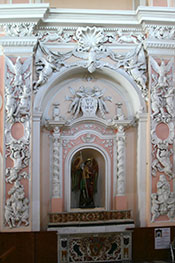 To the left there is the altar of the Madonna delle Grazie, (the picture of 1646, is attributed to Giuseppe Tomasio), that of Jesus and Maria, the San Giuseppe chapel and the San Michele Archangel altar with an elegant arch of baroque style. To the left there is the altar of the Madonna delle Grazie, (the picture of 1646, is attributed to Giuseppe Tomasio), that of Jesus and Maria, the San Giuseppe chapel and the San Michele Archangel altar with an elegant arch of baroque style.
At the end of the chorus stands the mayor altar dedicated to the Annunciated. The Chapel of Cristo alla Colonna opens with a travertine arch all in gilded bas-relief and differently colored, with the pediment surmounted by three spires worked to flower patterns. Vases with several friezes and flowers on the inside and outside adorn the columns; those of the base to the right are supported by winged lions, those to left by animals with sphinx face, rather than lions. The travertine arch, very beautiful work of art of the Renaissance, is placed in the room of the big entry to the chapel, which makes presume that it was taken there and raised afterwards. In the niche of the chapel is found the statue of Cristo alla Colonna, which, according to some people, was taken from the church of the SS. Christ, above San Vito, buried by the lava.
The tradition says that it is the work of a brontese shepherd. The statue, in paper-pulp, shows Christ in natural size, with hands tied to the back, bound to a column, the bleeding body covered with sores and the face expressing human pain. The work evokes with great realism the drama of the passion; every year, on Venerdì Santo (Holy Friday), it is taken on to a very heavy wooden frame in procession; he precedes all the other statues: the Crucifix, Christ Dead and the Grieved Lady.
The Annunciated
The Annunciated ext to the chapel is found a rectangular wooden little balcony supported by big corbels to the altar and, on the left, a wooden pulpit with canopy. |